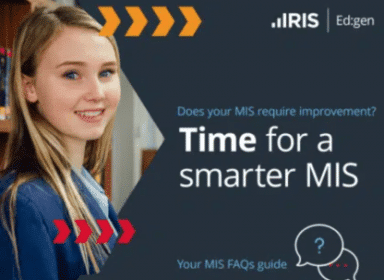What is safeguarding in schools?
As defined by the Department for Education (DfE), safeguarding in schools encompasses:
- Protecting children from maltreatment
- Preventing the impairment of children’s mental and physical health or development
- Ensuring that children grow up in circumstances consistent with the provision of safe and effective care
- Taking action to enable all children to have the best outcomes
School safeguarding is a huge priority, but it’s not without its challenges. Due to growing class sizes, high workloads and reduced contact with parents, school and trust leadership often struggle to see the bigger picture.

Online safety and safeguarding in schools
Today, many pupils have unlimited and unrestricted access to the internet via their mobile phones or smart devices.
This can mean that children are at risk of being exposed to potentially harmful, age-inappropriate content and online harassment, which can negatively impact their wellbeing. This can include:
- Cyberbullying, particularly via social media platforms
- Misogyny, racism, homophobia or other forms of discrimination
- Extremist ideologies that can lead to radicalisation
Students may bring concerning views into school, causing further school safeguarding issues.
While teachers can’t control what pupils have access to outside of school, robust mobile technology policies and child protection policies can help protect children when they’re on school premises.

Featured Guide
Safeguarding in education: a guide for schools and trusts
Effective school safeguarding policies and strategies are essential if you want to protect your students from harm.
Download our guide and learn how your school can take a smarter approach. Discover insights, including:
- Why is safeguarding important in schools?
- Keeping your students safe online
- Tackling bullying
- Safeguarding in out-of-school settings
- Effective information sharing
- The importance of centralised data
- Improving safeguarding within schools
Safeguarding against cyberbullying and online harassment in schools
Due to their growing internet use, children aged 8-17 are at increased risk of cyberbullying. Here are some of the most common signs that a child might be experiencing online harassment:
- Changes to their mood, such as depression, aggression or appearing withdrawn
- Physical symptoms like headaches and stomach aches
- High absenteeism from school
- A lack of care in their school work
School staff can benefit from a system that allows them to record data relating to their students’ attendance, attainment and wellbeing, so that suitable action can be taken. Plus, data like this allows leadership to quickly spot trends and make more informed strategic decisions.

How can schools and trust leadership improve safeguarding in schools?
Safeguarding within schools is equally important in both primary and secondary school settings.
Implementing measures to protect your children by building them into your school safeguarding policy allows you to help students sooner rather than later.
Let’s look at some of the ways to ensure your school safeguarding processes are the best they can be:
-
Make it simple
Make it easy for teaching staff to keep track of safeguarding concerns so it’s easier to act on them. If you’re reflecting on how your trust or school facilitates this, here are some points to consider:
- Does your school or trust juggle between different apps or systems?
- Do you record safeguarding issues in a way that feels consistent?
- How simple is it to produce an audit trail?
- Can you easily tally up data such as behaviour and attendance?
It’s never too early or too late to review your current school safeguarding procedures to explore whether they are best serving your students. If they’re not, it could be time to upgrade to a different system.
-
Act early
Students interact with a wide range of school staff every day, from teaching assistants to lunchtime supervisors.
Staff know they must act on early warning signs if they are worried about a student. But while they can do their utmost to protect their pupils, schools are busy environments – and sometimes, either signs are missed, or educators don’t have the right tools in place to connect the dots and see where the problems lie.
Trusts or schools might consider using a management information system (MIS) with built-in school safeguarding functionality. This allows you to easily record early warning signs, such as increased absences, rather than using a separate safeguarding app to log concerns which might get lost down the line.
-
Collaborate
To improve safeguarding in education, schools are looking at better ways to collaborate with out-of-school settings (OOSS) such as after-school clubs and sports courses.
OOSS aren’t subject to mandatory safeguarding reporting and regulation, so students who are struggling could slip through the net despite OOSS staff having concerns about their wellbeing.
To improve school safeguarding, consider whether your school MIS allows you to easily share information or safeguarding policies with OOSS. By collaborating with OOSS, local authorities, and agencies, school and trust leadership can be better equipped to notice trends and spot areas of concern.
-
Centralise your student data
Educators with school safeguarding concerns need an easy way to see the broader picture.
For example: a student experiences a sudden drop in their grades. Rather than seeing it as a standalone issue, teaching staff should be able to look at other factors, such as:
- Issues or areas of concern logged by other members of staff
- Attendance records
- Personal background
- Medical history (both physical and mental)
By combining the drop in grades with data like a sudden increase in absences and relevant insight into their home life (e.g. the recent death of a loved one), teachers have a clearer idea of what’s going on and can intervene quicker.
The better connected your staff and systems are, the better your approach to school safeguarding.
-
Automate tasks and workflows
School staff need to communicate with each other, but it can be challenging during a busy school day.
Examples of poor safeguarding practices in schools might include a teacher forgetting to follow through on a safeguarding concern, despite being alerted to a potential issue by a pastoral leader.
Explore how you’re using your system’s safeguarding functionality and whether it’s serving you well enough. Top-notch safeguarding features allow teaching staff to assign tasks to their teams (e.g. checking in on a student experiencing online harassment) with alerts to remind colleagues when to take action.
Make it simple
Make it easy for teaching staff to keep track of safeguarding concerns so it’s easier to act on them. If you’re reflecting on how your trust or school facilitates this, here are some points to consider:
- Does your school or trust juggle between different apps or systems?
- Do you record safeguarding issues in a way that feels consistent?
- How simple is it to produce an audit trail?
- Can you easily tally up data such as behaviour and attendance?
It’s never too early or too late to review your current school safeguarding procedures to explore whether they are best serving your students. If they’re not, it could be time to upgrade to a different system.
Frequently asked questions
Safeguarding in education is a vast topic. Here are some frequently asked questions about safeguarding in schools to help improve your approach.
-
Unfortunately, schools and trusts can encounter students experiencing one or more of a wide range of safeguarding concerns, including:
- Physical, sexual or emotional abuse
- Neglect or mistreatment
- Bullying – both in-person and online
- Radicalisation and extremism
- Misogyny, racism, homophobia and other forms of discrimination
- Child exploitation
By working with appropriate professionals and having access to clear and joined-up student data, educators can be better equipped to help protect students and maintain effective safeguarding in schools.
-
Yes, information sharing can improve safeguarding processes in schools and trusts – but only if it’s done correctly and in line with relevant legislation. Working alongside other professionals and using a secure platform is critical to successful safeguarding in schools.
The Department of Education (DfE) states that schools must store information securely. DfE guidance also says:
- Files should only be accessed by the people who need to see them
- Schools must follow information-sharing advice when they share files or data
For further clarity on information sharing, visit the GOV.UK website.
-
Without consolidated data, understanding the scattered accounts of various school staff is nearly impossible – especially when you’re overseeing multiple different schools. Even with centralised facts and figures, creating chronologies is demanding if you don’t use automation.
Sourcing a student’s name across numerous documents can involve hours of manual data compiling and admin. To achieve this, the person will also need data access under your school’s safeguarding and information-sharing policy.
If this is a challenge your trust or school is facing, an MIS that automatically compiles information could be your answer.
-
When a child is experiencing welfare issues, some signs are more obvious than others. Some indications include:
- Changes to behaviour, such as disruption or violence
- Attendance issues, such as repeatedly missing or skipping school
- Becoming withdrawn or no longer socialising with peers
- Reduced levels of hygiene or a sudden lack of self-care
- No longer being interested in hobbies or passions
Teaching staff need an effective way to record their concerns about their students. Using a MIS with built-in safeguarding reporting can make it easier for teachers and staff to record school safeguarding concerns, eliminating the need for system switching.
-
School and trust leadership is responsible for guiding their staff on the best way to protect their students from danger.
When staff and leadership don’t have the resources, tools or software needed to achieve this goal, we can start to see examples of poor safeguarding practices in schools, such as:
- Insufficient record-keeping
- Not sharing information with the right people
- Overlooking warning signs
- Inadequate communication with out-of-school-settings (OOSS)
Solutions like an accessible all-in-one MIS with effective safeguarding functionality can help empower staff with the tools they need to raise school safeguarding standards.
Learn more about safeguarding in education
Find helpful articles and resources discussing safeguarding from IRIS below

Guide
Implementing a new MIS: Your guide to getting it right
If you’re considering a new MIS for your school or trust, you’re not alone; it’s time to consider a smarter MIS.

Guide
How to harness your data to build a stronger trust
41% of teachers have stated that their school is collecting more data than they are regularly able to make use of. But what is the purpose of having so much data if schools and trusts can’t make proper use of it?

Guide
Time for a smarter MIS: Your MIS FAQs guide
Is your outdated MIS holding you back? But you aren’t sure how easy it is to switch? We have the answers.
